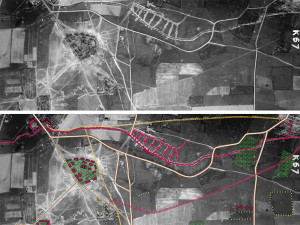
(WIRED Science 08-11-2014)
World War I is often considered a war of artillery, Stichelbaut says, “but, without aerial photography there would be no targets to fire at, there would be no maps indicating the positions of the enemy, commanders would simply have no idea what would be happening on the other side of the no-man’s-land separating opposing trench lines.”
A feature on the WIRED website Aerial Photography From WWI Shows the Massive Scale of Devastation explains the importance of aerial photography and the devastation of the was. “Aerial photography is often forgotten, yet it was perhaps one of the most deadly weapons of the war,” says co-author Birger Stichelbaut.
Rather than the personal perspective of bullets flying at bodies, these pictures show war’s toll on the landscape. In The Great War Seen From The Air, they’re accompanied by easy-to-read legends that point out strategic nuances that might be invisible to eyes unfamiliar with aerial imagery, and short paragraphs to explain each image’s significance to the broader conflict. Many of the photos have vellum paper overlays printed with bright icons to identify opposing front lines, barracks, artillery batteries, and supply lines.
The pictures are taken from too high an altitude to see the human drama below, but many of the pictures are taken over active combat. Even from a thousand feet in the air, it’s a crushing thing to see.